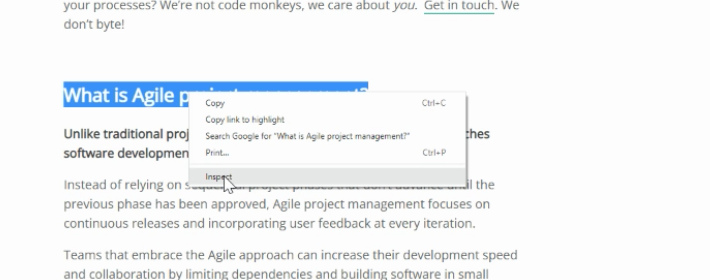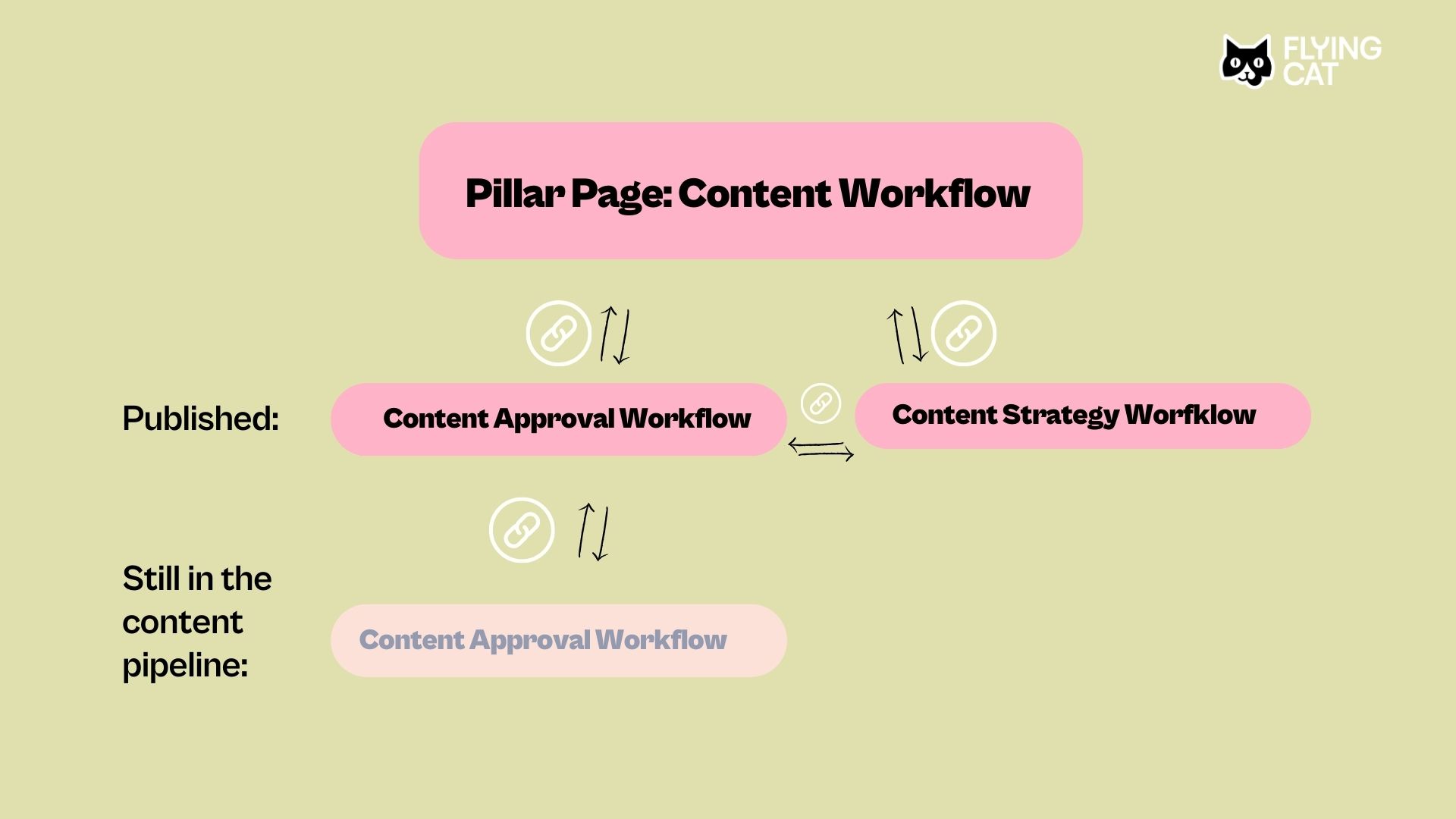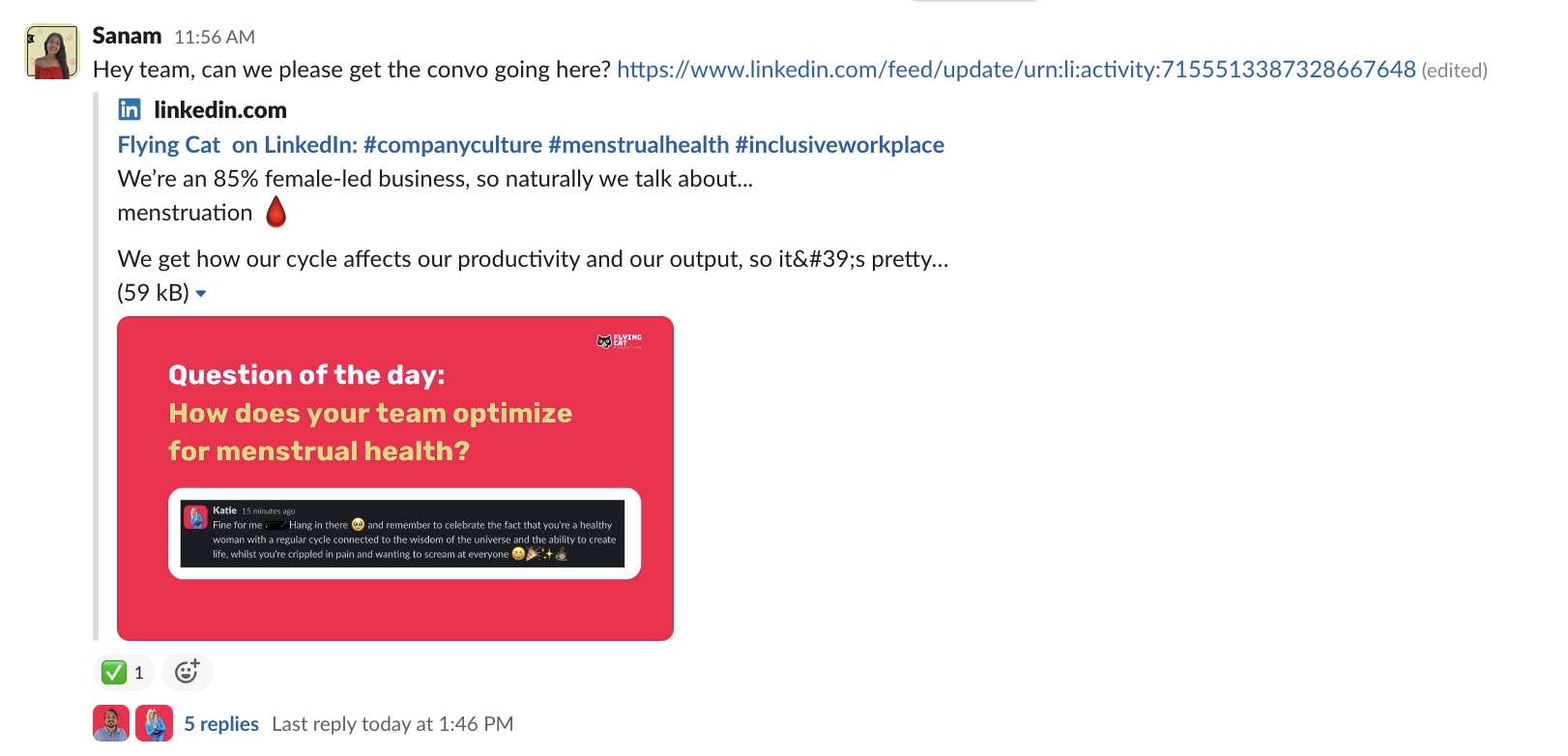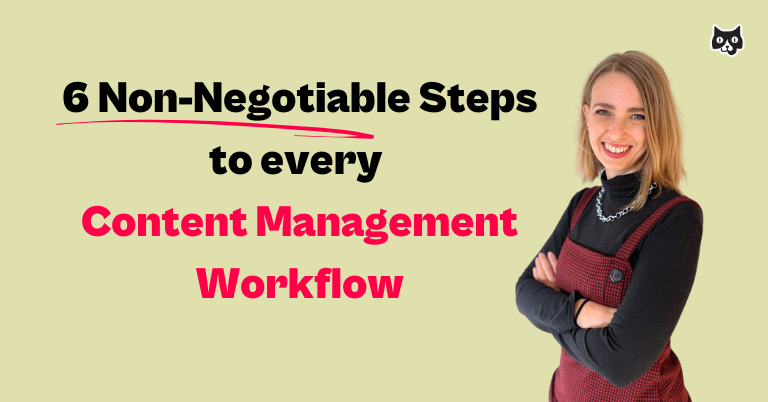If you’re creating content for marketing purposes, a content management workflow is essential, especially if you’re a small team. Processes and systems are your superpower, and with the right ones in place, you can churn out content that drives results & conversions.
In our early days at Flying Cat Marketing, a robust workflow meant the difference between struggling to keep up and scaling our efforts at pace. It’s about doing more with less, ensuring each piece of content packs the biggest punch in terms of engagement and conversion.
We’ll break down the six non-negotiable steps every content management workflow must have.
A content management workflow is the difference between failing and scaling
A content management workflow consists of a series of tasks that need to happen to ensure you always have enough content in the backlog (aka content pipeline), you and your team know what needs to worked on and by when it’s due, and handling everything that goes into getting a piece published.
We wrote about how to create that content workflow here, taking you through the ins and outs of what to keep in mind as you set up your workflow: From automations to approval stages, we’ve got you covered.
That’s the project management side of things. And it doesn’t just stop at publishing, there’s more to any successful content management workflow, as you’ll see below. Here are the 6 non-negotiable steps:
1. Content Planning: Define Your Content Goals
Begin with the end in mind: What do you want to achieve with your content? Do you want your user to book a demo? Or, do you want to get a newsletter sign-up? Every piece you write must have a measurable goal in place. Then, ensure your content is tailored to hit those objectives. If you’re ready to nerd out about this, we’ve got a piece solely about how to create a content strategy workflow.
This varies by company and size, as Hannah Cohen, Content Marketing Lead at Tango shared with us:
From a project management point of view, you’ll want to know exactly who needs be consulted versus informed, ensuring there’s no bottlenecks to getting the final approval on your content.
Your content creators need to be aligned with the marketing strategy and the overall purpose of each piece. That’s why content briefs are so important, especially if you outsource your content creation or work with freelancers.
Hannah Cohen shares a list that her team uses before putting pen to paper, because going off on your own—without alignment on the strategy and the overall purpose of the piece—is the fastest way to frustration. So, always check that you’re in the know of:
- What’s the target audience?
- Who are we not talking to?
- What are the key messages that we want to get across?
- What assumptions are we making about people who are reading or finding this piece?
- How are they going to find it?
- How are we going to distribute it?
- What are the repurposing plans for this piece of content?
- Who are the reviewers for this piece of content?
Make sure your content creators are crystal clear on the purpose and expected outcome for every piece, especially during the ideation phase.
2. Content Creation Process: Establish a Workflow
The workflow should be unique to you and your team, or the client you’re writing for. Even within Flying Cat, there are slight variations in this process tailored to each client.
Our project managers know the delicate balance between over-customizing (resulting in time-consuming, unscalable processes) vs. being too rigid (causing friction and hurting the client relationship).
So, here are two things every content management workflow must have: Clear timelines and boundaries.
Involve the right stakeholders at the right time: Specifically, when defining your content approval process, you can avoid the headache by defining the type of feedback the client can give during each stage.
Hannah has had the same experience in her content projects: “In content marketing, you’re constantly amassing feedback. And, that can add a lot of friction and delays to the content production process if you aren’t careful.”
One thing she’s learned is, “Be specific about the type of feedback that would be most helpful. Are we in the 10% stage where we can change a whole vision and it won’t negate tons of work? Or are we in the 99% stage where it’s a good time to nitpick about typos or tweak tone, but a very bad time to call the big-picture strategy into question? Making that distinction can really help keep things on the rails when you’ve got lots of stakeholders.”
For example, the outline stage of a content piece is the perfect moment to ask for feedback on the broader structure. It’s about setting clear expectations to avoid bottlenecks. At the final draft stage, the comments and change requests should be kept to a minimum. Here’s an automated message we send to our clients when an outline is ready for their review:

You can find templates like this in our SOP toolkit.
3. Publication: The Devil is in the Details
I wish publishing content was simply copy-pasting what your content team or freelance writers deliver, but it’s far from it. Don’t underestimate the time you and your team members need to spend here.
This step is key to enhance your content with SEO and boost the functionality of a piece.
Here’s the 14-point checklist our project managers follow when uploading content. You can use it as a template to create your own:

We tried automating the uploading step multiple times and weren’t very successful. Setting up a plug-in or an app for automation, only to find out it did a half-assed job wasn’t worth it. Despite content being automatically uploaded, we found ourselves fixing formatting issues and re-uploading images. It’s less of a hassle to do it block-by-block, ensuring everything is uploaded correctly. However, we’re eager to see if AI can nail that at some point for us.
💡 TIP: Define who is responsible for writing the meta-description and meta title, both items are necessary for uploading. Our content writers populate this section in the brief at the final draft stage. That way, we ensure that they also get edited. And now, thanks to AI, your project manager can create those snippets too.
Check published post for errors
Once the post is published, the work is far from done (which is why I emphasized not underestimating this step). This stage gets overlooked, but it’s so necessary. Here’s the checklist our content strategists made for us to follow. Feel free to use this checklist for your own content management workflow:
- Is the title tag correct? To check, hover over the tab and see if it matches your intentions:

- Are all the headings published as intended in the brief (H2, H3, etc.)? Highlight the titles and right-click to select “inspect”. A window will open on the right, showing the element you’re inspecting and indicate whether it’s an H2, H3, etc. Verify that it aligns with the brief:


- Are all the links working?
- Have you checked the links in the table of content (TOC)?
- Are all internal links in the content piece correct?
- Check UX & formatting:
- Are the numbered lists and bullet point lists looking good?
- Is the numbering of titles/lists correct?
- Is there enough space between image and text?
- Can you upload with a sticky TOC if possible?
Establish links between pillar pages
Another hidden gem that content marketers often overlook. Let’s say you’re working on a content cluster, and you don’t publish all articles at the same time.
A common approach in content production to publish the pillar page first. For instance, let’s use “Content Workflow” as an example. The content cluster would naturally include content pieces on a “Content Management Workflow”, “Content Approval Workflow” and similar topics.
Now, imagine “Content Strategy Workflow” is the last to be published according to the content calendar.
Naturally, all of the pieces in the cluster will link back to the pillar page. But, the pillar page must also link out to these pieces. The only problem is: They’re not published yet.

Even though you know the slug and their soon-to-be URL, you can’t add them yet or risk having a broken link on your pillar page. As each piece gets published, you must update the pillar page with links to the new articles and ensure they’re interlinked to each other:
For that to happen, you need to keep track of the editorial calendar closely. As articles like “Content Approval Workflow” get published, you’ll want to link to it in the pillar page, as well as related pieces like “Content Management Workflow”. Once the piece on content strategy goes live, include a link to in that piece too.
Here’s why including internal linking in your content creation process is so important:
- Enhanced SEO: Search engines, such as Google, use internal links to understand the structure and hierarchy of your website’s content. By strategically interlinking your webpages, you provide search engines with valuable signals about the importance and relevance of specific pages. Leading to improved search engine rankings for your content, as search engines are more likely to index and rank well-interlinked pages higher in search results.
- Improved User Experience: Interlinking helps users navigate your website easily by providing relevant links to related content. When visitors effortlessly find additional information on topics they’re interested in, they are more likely to spend more time on your site, engage with your content, and have a positive user experience. Increasing user satisfaction and higher chances of returning to your site in the future.
- Reduced Bounce Rate: Interlinking can reduce the bounce rate on your website, which is the percentage of visitors who leave your site after viewing only one page. When you provide internal links to related content, you encourage users to explore more of your website, lowering the likelihood of them leaving immediately. A lower bounce rate is generally seen as a positive signal by search engines and can contribute to improved SEO and higher user engagement.
💡 TIP: This is a key part of our content strategy. We map out the content clusters and determine which piece will be interlinked with the other pieces. Our project managers track any links that still need to be added, of links that still need adding. They only close the task once all internal links from the cluster are placed.
4. Distribution: Strategize Your Channels
Determine where and when to publish your content for maximum impact. You’ll only be able to do that if you understand your audience and the platforms they use most.
This is the step where you and the marketing team strategize and brainstorm tactics to enhance the visibility of your message to a broader audience.
For example, consider social media distribution – Only do this if your blog content yields results on social media. We’re over the days where we do social media posts for the sake of it. Loop the social media manager into the content calendar. Don’t waste time promoting an article on a channel where it doesn’t resonate and where your potential customers aren’t searching for a solutions or making buyer decisions.
Every business has a unique approach. Where and how you distribute relies heavily on your product or service. Chatting with Hannah Cohen from Tango offered great nuggets because their content marketing strategy targets both B2B and a B2C audiences. “We have an unusually nuanced approach to content because our [sales-led] enterprise product is for businesses who want to drive higher digital adoption. We connect with our internal champions and buyers on LinkedIn, through our website, through ads, etc. But, we also have a free [product-led] product, and we interact with the audience for our Chrome Extension more on TikTok and Instagram. How do we bridge the gap? With a 1+1 = 3 repurposing formula that helps us adapt everything we make for multiple channels and audiences.”
For instance, Flying Cat doesn’t use Instagram. Our main platform is Linkedin, along with our podcast – that’s where most of our publishing efforts went into.
3 Easy-to-follow Action Steps to Boost your Content Distribution:
- Have your team champion it on the social media channel where it will have the greatest impact. This can be as easy as “asking for some love on this post” once it’s live.
- Set up an automation that notifies subject matter experts who contributed to the post once it’s published. Chances are high they will share it among their network too, since their insights were included.
- Share your content in Slack communities & groups.

Repurposing and rescheduling content
It’s not always about creating shiny new content, sometimes it’s best to take a step back and look at how time and effort can be better spent repurposing content. Something that Tango has been doing more of lately:
Plus, really good content can get shared and re-shared multiple times, especially your most popular pieces.
“Even though we might be tired or talking about our value proposition or our category, customers are maybe just seeing it for the first time.”
Hannah Cohen, Content Marketing Lead at Tango
To show how easy that can be, here’s a real-life example: Our client, Sona, repurposed a blog post we created for them into a snippet on LinkedIn.

5. Analyzing: Measuring your content’s performance
Finally, analyze your content’s performance. Use metrics that align with your initial goals to understand what’s working and what needs improvement. This involves tracking metrics like engagement, traffic, and conversion rates to understand the impact of your content, as well as inform the future strategy. Set up traffic forecasting and monitor actual traffic to see if you’re hitting your goals or if you need to adjust your tactics.
6. Feedback and Optimization
Successful content doesn’t stop the moment you hit publish. Content that is not nurtured is losing out on traffic, clicks and conversions. It will catch cobwebs and reference outdated studies. Or even worse, it will have broken links and images and turn into a waste of time and resources.
A must for us it the end of year update, where we make sure content we’ve published such as “ Link Building Strategies that Actually Work in 2024” has the next year. Nobody wants to see Strategies from 2016.
Continuous improvement is integral to the success of your content. At Flying Cat, our optimization process is just as important as creating new content. This is relevant to those who have over 100 blog posts already published. Use these insights to refine your workflow and content strategy.
Here’s a quick overview of how it’s done:
- On a quarterly basis, we look at Google Search Console to identify growth opportunities:
- Are there keywords where we are ranking between position 5 to 20 which can be improved?
- Are there pages where we have low CTR (clickthrough rate) but rank on page 1?
- Are there pages with high impressions & low clicks? Are we meeting the search intent?
This data is then used to categorize the pieces into three types of optimization: Gold re-optimization involves a complete rewrite, while Silver and Bronze levels involve adding/changing words and metadata/subheadings, respectively.
Include these into the content plan for the next quarter in order of priority.
Valuable Extra Tips to build an Effective Content Creation Workflow
Ship frequently & ask for feedback early
This one comes from my conversation with Hannah Cohen, and it’s something all perfectionists will struggle with: sharing your work in progress. “That’s something that it was really hard for me to do at first because I’m a perfectionist. I don’t really love showing people a half completed draft or a work in progress, but it has hands down been the thing that has allowed me to keep the quality bar really high and move really fast.”
Keep your automations simple
Remember, the key for small teams is to keep the workflow simple yet effective. Don’t overcomplicate steps. Does everyone know what they need to do to make the automation work?
Is there a chance that someone in the team will trigger the automation accidentally at the wrong time? Automations and fancy processes are all nice and that, but if you need to explain the thing that’s automated too much, then that’s a red flag.
Prioritize the right content
In your content management process you should always prioritize the pieces that will yield the most outcome and that align with the marketing goals, customer goals and buyer journey.
Are you spending time and resources writing blog posts that will eventually just get buried at the end of your blog? Or is it going to be a flagship piece that your sales team will use and will get seen over and over again, and you can use it as a pillar page for a whole bunch of other content.
Optimize your content management workflow to work fast and create content that gets you results
An effective content management workflow isn’t just about keeping things organized; it’s your secret weapon in a competitive market. A streamlined workflow maximizes productivity and ensures consistent quality. Without it, you risk falling into a chaotic jumble of tasks, missing deadlines, or producing subpar content.
A streamlined workflow needs boundaries, timeline and clarity. Set expectations from the beginning and be clear about when feedback can be added in the most effective way.
It’s not just about creating new content all the time, consider investing your time into repurposing and distributing your content on channels that will support you in hitting the goals you set out to reach with your content.
Frequently asked questions about content management workflows:
What is a content management workflow, and why is it important?
The key is to develop a consistent process for creating content. While the content strategist decides the types of content you’ll produce, your content operations must define who is responsible for each task, and the tools you’ll use (like automations to make sure things move along as fast as possible). All along, the content creators must understand what it is that the marketing team wants to achieve with this piece of content.
Simply put, it’s a structured workflow that empowers small teams to streamline the way they work and to:
- Effectively manage limited resources and make sure you don’t waste any resources on things that don’t need to be done.
- Maintain a steady output of high-quality content.
Consistency: sticking to a workflow makes sure your work is scalable.
What are the most common challenges in creating content management workflows?
- Lack of clarity on roles and responsibilities: Not clearly defining who is responsible for each step of the process can lead to confusion, bottlenecks, and missed deadlines.
- Overly complex processes: Trying to automate or systematize everything can result in workflows that are too intricate to easily follow and sustain. Simplicity is key.
- Getting stakeholder buy-in: When getting feedback, be clear when something is an objection or a suggestion
- Resource constraints: Limited time, budget or personnel can make it hard to fully execute planned workflows in a consistent manner. Keep it simple!
- Inflexibility: If the workflow can’t adapt to changing priorities or opportunities, it won’t remain relevant as strategies evolve.
